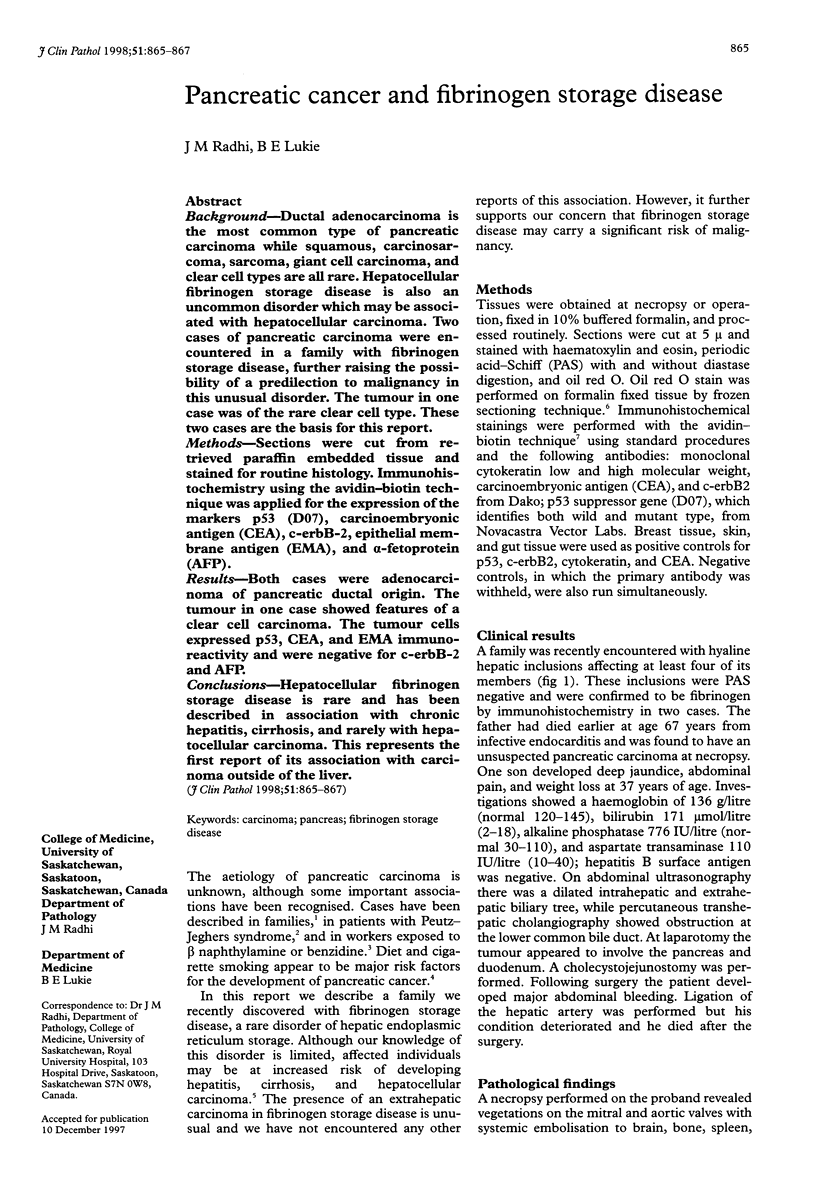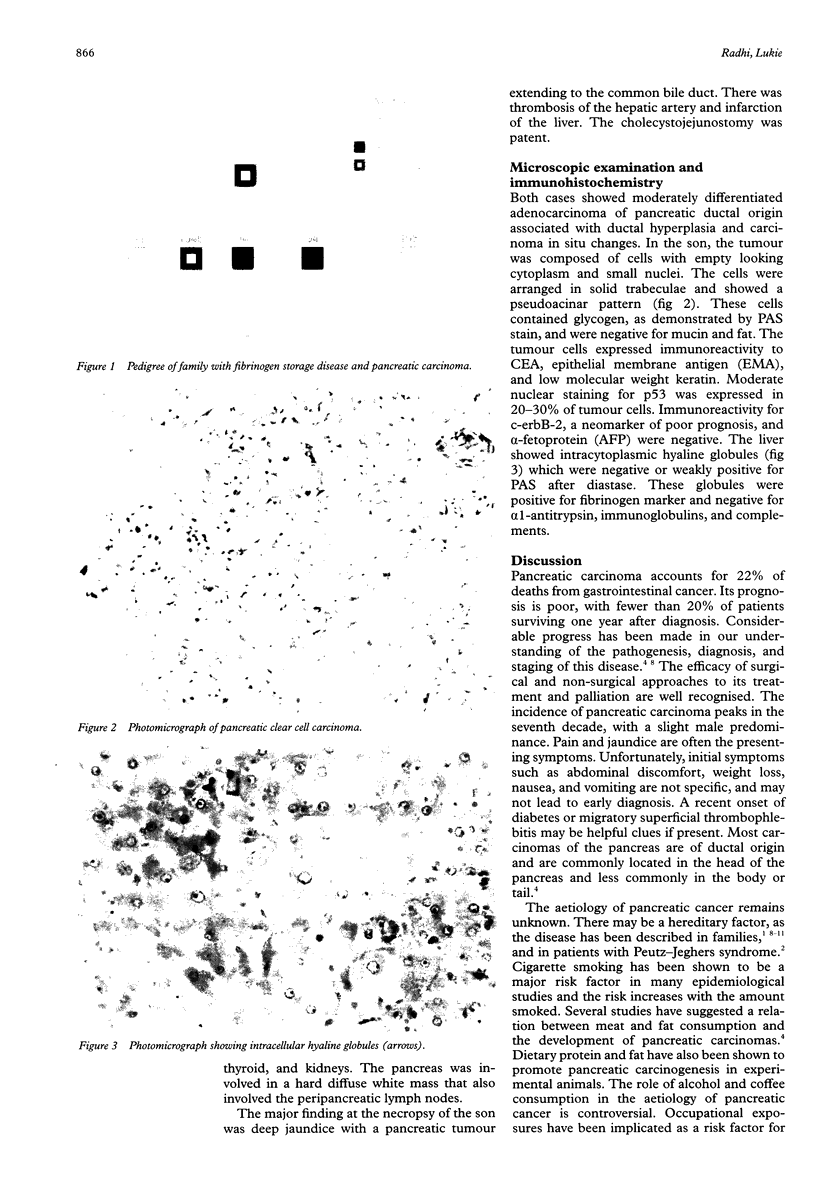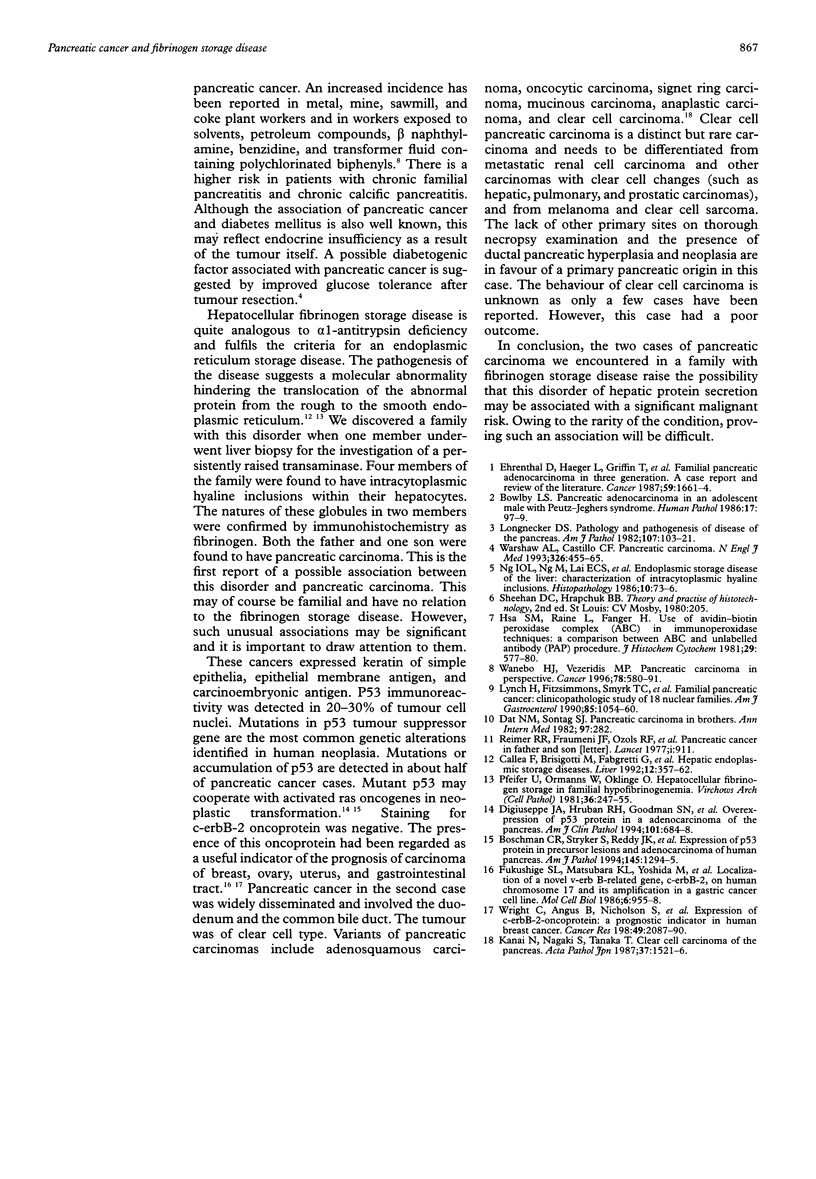Abstract
BACKGROUND: Ductal adenocarcinoma is the most common type of pancreatic carcinoma while squamous, carcinosarcoma, sarcoma, giant cell carcinoma, and clear cell types are all rare. Hepatocellular fibrinogen storage disease is also an uncommon disorder which may be associated with hepatocellular carcinoma. Two cases of pancreatic carcinoma were encountered in a family with fibrinogen storage disease, further raising the possibility of a predilection to malignancy in this unusual disorder. The tumour in one case was of the rare clear cell type. These two cases are the basis for this report. METHODS: Sections were cut from retrieved paraffin embedded tissue and stained for routine histology. Immunohistochemistry using the avidin-biotin technique was applied for the expression of the markers p53 (D07), carcinoembryonic antigen (CEA), c-erbB-2, epithelial membrane antigen (EMA), and alpha-fetoprotein (AFP). RESULTS: Both cases were adenocarcinoma of pancreatic ductal origin. The tumour in one case showed features of a clear cell carcinoma. The tumour cells expressed p53, CEA, and EMA immunoreactivity and were negative for c-erbB-2 and AFP. CONCLUSIONS: Hepatocellular fibrinogen storage disease is rare and has been described in association with chronic hepatitis, cirrhosis, and rarely with hepatocellular carcinoma. This represents the first report of its association with carcinoma outside of the liver.
Full text
PDF


Images in this article
Selected References
These references are in PubMed. This may not be the complete list of references from this article.
- Bowlby L. S. Pancreatic adenocarcinoma in an adolescent male with Peutz-Jeghers syndrome. Hum Pathol. 1986 Jan;17(1):97–99. doi: 10.1016/s0046-8177(86)80163-0. [DOI] [PubMed] [Google Scholar]
- Callea F., Brisigotti M., Fabbretti G., Bonino F., Desmet V. J. Hepatic endoplasmic reticulum storage diseases. Liver. 1992 Dec;12(6):357–362. doi: 10.1111/j.1600-0676.1992.tb00589.x. [DOI] [PubMed] [Google Scholar]
- Dat N. M., Sontag S. J. Pancreatic carcinoma in brothers. Ann Intern Med. 1982 Aug;97(2):282–282. doi: 10.7326/0003-4819-97-2-282_1. [DOI] [PubMed] [Google Scholar]
- DiGiuseppe J. A., Hruban R. H., Goodman S. N., Polak M., van den Berg F. M., Allison D. C., Cameron J. L., Offerhaus G. J. Overexpression of p53 protein in adenocarcinoma of the pancreas. Am J Clin Pathol. 1994 Jun;101(6):684–688. doi: 10.1093/ajcp/101.6.684. [DOI] [PubMed] [Google Scholar]
- Ehrenthal D., Haeger L., Griffin T., Compton C. Familial pancreatic adenocarcinoma in three generations. A case report and a review of the literature. Cancer. 1987 May 1;59(9):1661–1664. doi: 10.1002/1097-0142(19870501)59:9<1661::aid-cncr2820590923>3.0.co;2-h. [DOI] [PubMed] [Google Scholar]
- Fukushige S., Matsubara K., Yoshida M., Sasaki M., Suzuki T., Semba K., Toyoshima K., Yamamoto T. Localization of a novel v-erbB-related gene, c-erbB-2, on human chromosome 17 and its amplification in a gastric cancer cell line. Mol Cell Biol. 1986 Mar;6(3):955–958. doi: 10.1128/mcb.6.3.955. [DOI] [PMC free article] [PubMed] [Google Scholar]
- Hsu S. M., Raine L., Fanger H. Use of avidin-biotin-peroxidase complex (ABC) in immunoperoxidase techniques: a comparison between ABC and unlabeled antibody (PAP) procedures. J Histochem Cytochem. 1981 Apr;29(4):577–580. doi: 10.1177/29.4.6166661. [DOI] [PubMed] [Google Scholar]
- Kanai N., Nagaki S., Tanaka T. Clear cell carcinoma of the pancreas. Acta Pathol Jpn. 1987 Sep;37(9):1521–1526. doi: 10.1111/j.1440-1827.1987.tb02273.x. [DOI] [PubMed] [Google Scholar]
- Longnecker D. S. Pathology and pathogenesis of diseases of the pancreas. Am J Pathol. 1982 Apr;107(1):99–121. [PMC free article] [PubMed] [Google Scholar]
- Pfeifer U., Ormanns W., Klinge O. Hepatocellular fibrinogen storage in familial hypofibrinogenemia. Virchows Arch B Cell Pathol Incl Mol Pathol. 1981;36(2-3):247–255. doi: 10.1007/BF02912070. [DOI] [PubMed] [Google Scholar]
- Reimer R. R., Fraumeni J. F., Jr, Ozols R. F., Bender R. Pancreatic cancer in father and son. Lancet. 1977 Apr 23;1(8017):911–911. doi: 10.1016/s0140-6736(77)91244-2. [DOI] [PubMed] [Google Scholar]
- Wanebo H. J., Vezeridis M. P. Pancreatic carcinoma in perspective. A continuing challenge. Cancer. 1996 Aug 1;78(3 Suppl):580–591. doi: 10.1002/(SICI)1097-0142(19960801)78:3<580::AID-CNCR38>3.0.CO;2-T. [DOI] [PubMed] [Google Scholar]
- Warshaw A. L., Fernández-del Castillo C. Pancreatic carcinoma. N Engl J Med. 1992 Feb 13;326(7):455–465. doi: 10.1056/NEJM199202133260706. [DOI] [PubMed] [Google Scholar]
- Wright C., Angus B., Nicholson S., Sainsbury J. R., Cairns J., Gullick W. J., Kelly P., Harris A. L., Horne C. H. Expression of c-erbB-2 oncoprotein: a prognostic indicator in human breast cancer. Cancer Res. 1989 Apr 15;49(8):2087–2090. [PubMed] [Google Scholar]





